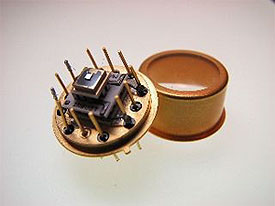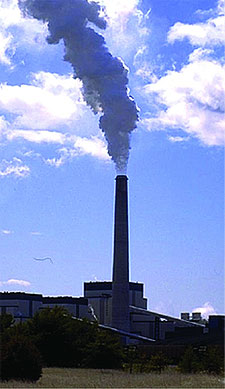By Gary Boas, News Editor
Demand for infrared detectors is growing in a variety of application areas, especially in military, medical and environmental monitoring applications. Here, we look at how two recent developments in infrared detection technology are helping to meet this demand.
Companies developing infrared detectors have long sought alternatives to the conventional photomultiplier tube technology. In Brooklyn, N.Y., Amplification Technologies Inc. has devised a technology that re-creates the characteristics of a photomultiplier tube in the much smaller semiconductor. Dubbed “discrete amplification,” the technology allows electron amplification of 1 million within a semiconductor without any increase in noise levels. “This will allow CCD-like imaging at low light levels in the infrared, with similar types of array scaling,” said the company’s Wayne Seemungal.
Achieving this degree of amplification is relatively straightforward, he said. The challenge lies in controlling the gain. Avalanche photodiodes operating in the Geiger mode – another high-gain, semiconductor-based alternative to photomultiplier tubes – suffer runaway gain. Systems designers typically address this by including external quenching circuits on the diode, but this means that the device must be reset.
“Our device operates in the same Geiger regime, but it operates continually without having to reset – just like in a photomultiplier tube. In addition, it can be implemented in various semiconductors. This gives it the flexibility to cover a wide range of wavelengths. Everything from the UV down to the far-infrared is theoretically possible.”

A new infrared detection technology called discrete amplification – shown here mounted on a thermoelectric cooler – enables electron amplification of 1 million within a semiconductor, without any accompanying increase in noise levels.
A variety of applications could benefit from use of the device. In the infrared, night-vision applications – primarily for military use – constitute one of the largest markets for InGaAs detectors. These applications require rugged detectors that can see in very low light. Lidar applications call for detectors that are very fast; another key feature of the discrete amplification technology is the subnanosecond response time, Seemungal said.
Currently, the military uses image intensifiers, thermal imaging and a variety of other types of infrared detectors for night-vision applications. “All of these are adequate,” Seemungal noted, “but none are optimal. In many cases, it’s sort of like looking at a negative of a photograph.” He added, however, that the new technology would not entirely replace any of these, but rather would complement them.
Finally, because the technology is scalable to large arrays, it could facilitate a wide field of view for advanced helmet-mounted displays, or displays in tanks or in the cockpits of planes. Image intensifiers cannot provide this wide field of view. Achieving such large arrays can be difficult with other types of semiconductor systems. For most semiconductors, he said, the cost increases superlinearly with the size of the array.
Multicolor sensing
Earlier this year, Cal Sensors Inc. of Santa Rosa, Calif., introduced a four-color lead selenide (PbSe) sensor – the MIRA4 – with sensitivity of 1.5E10 Jones for detection of up to four distinct gases in the 1- to 5.5-µm infrared region.

There is a growing demand for infrared detection of gases in the environment, including monitoring of industrial plant emissions, vehicle exhaust and carbon monoxide buildup in buildings.
With gas analysis, users often want to look at several channels, said Brian Elias, director of engineering at the company. Typically, this requires multiple detectors, multiple interfaces, optics with which to split the beam – “a fairly complicated arrangement.” The MIRA4 incorporates four detectors in a single package, and each of the four channels has a customer-specified optical filter on it, enabling users to monitor up to four gases, or three gases and a reference, with the one system.
This quad configuration allows for lower costs compared with using four individual-element detectors. It also results in a much smaller package. Each detector measures 1 mm2, and the cluster is housed in a single industry-standard TO5 package measuring 8.2 mm in diameter and 6.3 mm in height. The small size and low power consumption are important because, for many applications, the detectors must be incorporated into portable analysis and measurement systems.
Medical gas analysis is one of the fastest-growing application areas for IR detectors. As the baby boomer generation ages, unprecedented numbers of people are requiring care. And, significantly, they often expect the latest noninvasive technologies to deliver that care. Infrared detectors are finding use in many of these technologies, oftentimes for anesthesia and expirant gas analysis. For example, sleep apnea clinics are employing portable gas analysis systems, which patients can take home to monitor carbon dioxide levels while they are sleeping.
Other growing application areas include “green” initiatives such as environmental monitoring of smokestacks; for example, looking at emissions to ensure that carbon monoxide levels do not rise above a certain threshold. Detectors also can aid in the analysis of materials for recycling.
Having launched the MIRA4, Cal Sensors looked to develop an emitter with which to take advantage of the device. “With detectors,” Elias explained, “you can get much better performance if you modulate the information coming in,” eliminating much of the noise and, thus, increasing the signal-to-noise ratio. Conventional systems achieve this using a chopper, a sort of fan blade, which serves to modulate the optical energy coming from the emitter. But this approach is “not really conducive to high reliability or small size,” especially as the trend toward more compact systems continues.
For this reason, the company developed the PIREPlus pulsed emitter, which it will introduce at the Photonics West show in January. This source can be pulsed at 180 Hz – roughly 18 times the speed of many conventional technologies – at 50 percent modulation depth, enabling accurate readings with considerably lower parts-per-million concentrations.
The emitter is compatible with a range of IR detector technologies and can be purchased with the MIRA4 detector as an integrated module. This allows for quick integration, while the efficient design of each facilitates ease of use and helps to reduce the space occupied by the system.
“We’ve been surveying the market,” said Larry Johnson, president of Cal Sensors, “and have found that many of the customers are interested in us providing more than just the detector. Especially as the worsening economy has forced many of them to cut staff, they are seeking smaller plug-and-play systems that allow them to focus on their core competencies. Bundling the emitter and detector helps us meet the evolving needs of our customers.”
Gary Boas
[email protected]